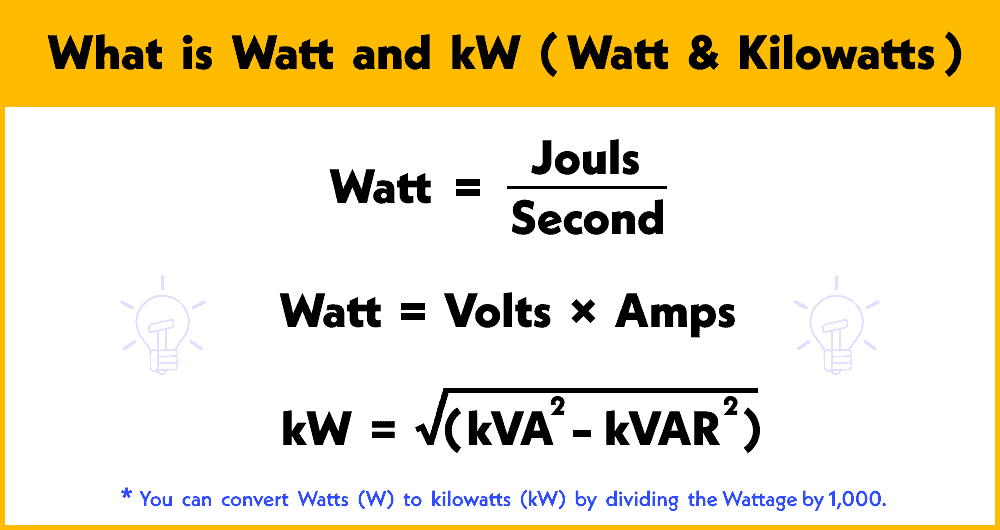What is Watt & kW (Watt & Kilowatt)? – Definition, Formula and Calculation
What is Kilowatt (kW) and Watt (W)? – Definition, Formula, Example and Calculation
What is Watt?
The watt is a standard unit of power that quantifies the rate at which work is done or energy is transferred. Electrical power is measured using a unit known as the watt (W). Named after the Scottish engineer James Watt.
What is kW?
It is nothing new but a bigger unit of watt. For example, if an appliance consumes 1,000 watts, it is known to be 1kW. To convert the watt to kW, simply divide the wattage rating by 1,000. Same is the case for even bigger and biggest units i.e. mega watts (MW = 1×106 Watts) , giga watts (GW = 1×109 Watts) etc.
Definition, Derivation & Unit:
The watt is the unit of electric power and defined as one joule of energy per second. To understand this definition, it is essential to grasp the concept of energy and work. Energy is the capacity to do work, while work is the application of force over a distance. When one joule of work is performed in one second, it corresponds to a power output of one watt.
Mathematically, the watt can be derived from the equation
P = W ÷ t
or
Watt = Joules ÷ Second
W = J ÷ Sec
Where
- P represents power
- W denotes work,
- t signifies time.
- J is equal to joules
- sec = time in seconds
Since work is measured in joules (J) and time in seconds (s), the unit of power becomes watts. This derivation demonstrates the fundamental relationship between energy, work, and power.
Alternatively,
Power in Watts = Voltage in Volts × Current in Amperes
- P = V × I … In Watts … (DC Circuits)
- P = V × I × Cosϕ … In Watts … (1-Phase AC Circuits)
- P = √3 × VL × IL × Cosϕ … In Watts … (3-Phase AC Circuits)
It is said to be one watt when the power consumed by one volt of potential difference forces one ampere of current to flow in a circuit.
Related Posts:
- Active, Reactive, Apparent and Complex Power
- Difference Between Active and Reactive Power – Watts vs VA (kW vs kVA)
Prefixes and Multiples:
The watt can be further expressed in multiples or fractions to accommodate a wide range of power levels. The International System of Units (SI) incorporates several prefixes to facilitate easy conversions and provide a more manageable representation of power.
Some common prefixes used with the watt are kilo- (kW), mega- (MW), and giga- (GW). These indicate multiples of 1,000, 1,000,000, and 1,000,000,000 watts, respectively. For instance, a large power plant might have a capacity of several hundred megawatts (MW), while a small electronic device could operate on a few watts (W) of power.
Watt Equations used for Conversions to the Related Quantities
Watts from Volts and Amps
- W = V × A
- Watts = Volts × Amperes … (P = V × I)
Watts from Joules and Seconds
- W = J ÷ Sec
- Watts = Joules ÷ Seconds
Watts from Amps and Resistance
- P = I2 × R … (Ohm’s law)
- Watts = Amp2 × Ohms (Ω)
kW from kVA and Power factor
- kW = kVA x Cosϕ (power factor)
- kilowatts = kilo-reactive power
kW from kVA and kVAR
- kW = √(kVA2 – kVAR2)
- kilowatts = √( kilo-apparent power2 – kilo-reactive power2)
Calculation of W and kW.
Example 1: If 25A of current is flowing to a 240V connected circuit, what is the consumption of load in wattage?
Solution:
P = V × I = 240V × 25A = 6000W = 6kW.
Example 2: Calculate the power consumption in kW if 5000 joules of energy was released during 30 second?
Solution:
P = J/s = 5000 × 30 = 150000 / 1000 = 150 kW.
Application and Equivalents:
The watt is employed across various scientific and engineering disciplines, with applications ranging from electricity generation and consumption to mechanical systems. Understanding the power rating of devices and systems is crucial for their efficient operation and compatibility.
In the field of electricity, the watt is commonly used to measure the power consumption or output of electrical appliances, lighting fixtures, and electronic devices. For example, a typical incandescent light bulb may consume 60 watts, indicating the rate at which electrical energy is converted into light and heat. Similarly, the power output of a motor or generator can be expressed in watts, providing insights into its performance capabilities.
In the context of mechanical systems, the watt is utilized to evaluate the power output or capacity of engines, turbines, and other machinery. It enables engineers to assess the efficiency and effectiveness of these systems, aiding in design and optimization processes. The watt is particularly important in fields such as automotive engineering, where engine power ratings are critical for vehicle performance and comparisons.
Summary
The watt, named after James Watt, is a fundamental unit of power. It quantifies the rate at which work is done or energy is transferred. By measuring power, scientists and engineers can evaluate the efficiency and performance of various systems, ranging from electrical appliances to mechanical machinery. The watt’s versatility is enhanced by the use of prefixes, allowing for convenient expression across a wide range of power levels. Understanding the concept of the watt is essential for anyone involved in fields related to energy, engineering, and physics, as it forms the foundation for power analysis and optimization.
Related Posts:
- What is kWh (Kilowatt hour)? – Definition, Formula and Calculation
- What is Volt (V)? Unit of Electrical Potential and Voltage
- What is Ampere (A)? Unit of Electrical Current
- What is Ohm (Ω)? Unit of Electrical Resistance and Impedance
- What is Voltage? its Unit, Formula, Types & Applications
- What is Electric Current, its Unit, Formula, Types & Applications
- What is Electrical Power? Types of Electric Power and their Units







